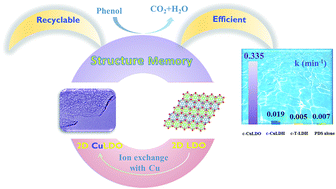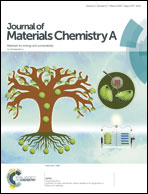Thin CuOx-based nanosheets for efficient phenol removal benefitting from structural memory and ion exchange of layered double oxides†
Abstract
Despite extensive efforts dedicated to researching two-dimensional (2D) transition metal oxides (TMOs), significant challenges still remain to simplify their synthesis and improve the activity and reusability of these materials. In this work, we prepared a 2D Cu-containing layered double oxide (CuLDO) under mild conditions. Only via stirring LDO in diluted Cu solution at room temperature could ion exchange between Mg in LDO and Cu ions from that solution allow fixing of Cu onto the surfaces of LDO nanosheets with good dispersion at a high density. The obtained CuLDO was then annealed to give CuOx-rich nanosheets (denoted as c-CuLDO), which maintained a thin thickness of 5–9 nm with a flowers-like architecture thanks to the structural memory of the source materials. The excellent morphology of CuOx-based nanosheets helped to avoid the restacking of nanosheets. Such a c-CuLDO outperformed many other reported Cu-based nanomaterials as a catalyst in phenol degradation (k = 0.335 min−1) because c-CuLDO could efficiently activate persulfate to generate abundant amounts of sulfate radical (SO4˙−). Furthermore, the catalytic activity of used c-CuLDO could be restored by a simple hydrothermal treatment. The developed chemistry could also be used to remove copper ions from wastewater, generating value-added Cu-based nanomaterials and eliminating waste at the same time. The current results may inspire the design of novel low dimensional nanomaterials that are difficult to synthesize directly by conventional bottom-up strategies.



 Please wait while we load your content...
Please wait while we load your content...